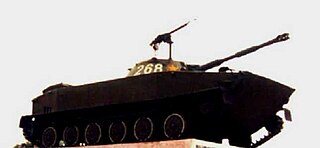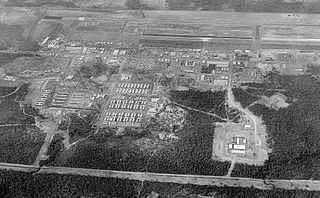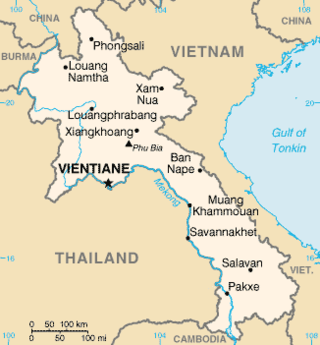| |||||
| Decades: | |||||
|---|---|---|---|---|---|
| See also: | Other events of 1967 List of years in Laos | ||||
The following lists events that happened during 1967 in Laos .
| |||||
| Decades: | |||||
|---|---|---|---|---|---|
| See also: | Other events of 1967 List of years in Laos | ||||
The following lists events that happened during 1967 in Laos .

Laos, officially the Lao People's Democratic Republic, is the only landlocked country in Southeast Asia. It is bordered by Myanmar and China to the northwest, Vietnam to the east, Cambodia to the southeast, and Thailand to the west and southwest. Its capital and most populous city is Vientiane. The country is characterized by mountainous terrain, Buddhist temples including the UNESCO World Heritage site of Luang Prabang, and French colonial architecture.

Luang Phabang, or Louangphabang, commonly transliterated into Western languages from the pre-1975 Lao spelling ຫຼວງພຣະບາງ as Luang Prabang, literally meaning "Royal Buddha Image", is a city in north central Laos, consisting of 58 adjacent villages, of which 33 comprise the UNESCO Town of Luang Prabang World Heritage Site. It was listed in 1995 for unique and remarkably well preserved architectural, religious and cultural heritage, a blend of the rural and urban developments over several centuries, including the French colonial influences during the 19th and 20th centuries.

The Pathet Lao, officially the Lao People's Liberation Army, was a communist political movement and organization in Laos, formed in the mid-20th century. The group ultimately gained control over the entire country of Laos in 1975, after the Laotian Civil War. The Pathet Lao were always closely associated and dependent on Vietnamese communists and North Vietnam since their foundation, with the group being established after advice from Hanoi to create a Laotian counterpart of the Viet Minh or Viet Cong. During the civil war, it was effectively organised, equipped and even led by the People's Army of Vietnam (PAVN). They fought against the anti-communist forces in the Vietnam War. Eventually, the term became the generic name for Laotian communists. Under orders from Mao Zedong, the People's Liberation Army provided 115,000 guns, 920,000 grenades and 170 million bullets, and trained more than 700 of its military officers.

The Laotian Civil War was waged between the Communist Pathet Lao and the Royal Lao Government from 23 May 1959 to 2 December 1975. The Kingdom of Laos was a covert theater during the Vietnam War with both sides receiving heavy external support in a proxy war between the global Cold War superpowers. The fighting also involved the North Vietnamese, South Vietnamese, American and Thai armies, both directly and through irregular proxies. The war is known as the Secret War among the American CIA Special Activities Center, and Hmong and Mien veterans of the conflict.

The Battle of Khe Sanh was conducted in the Khe Sanh area of northwestern Quảng Trị Province, Republic of Vietnam, during the Vietnam War. The main US forces defending Khe Sanh Combat Base (KSCB) were two regiments of the United States Marine Corps supported by elements from the United States Army, the United States Air Force (USAF) and the RAAF, as well as a small number of Army of the Republic of Vietnam (ARVN) troops. These were pitted against two to three divisional-size elements of the North Vietnamese People's Army of Vietnam (PAVN).

The Battle of Lang Vei began on the evening of 6 February 1968 and concluded during the early hours of 7 February, in Quảng Trị Province, South Vietnam. Towards the end of 1967, the 198th Tank Battalion of the People's Army of Vietnam's (PAVN) 202nd Armored Regiment received instructions from the North Vietnamese Ministry of Defense to reinforce the 304th Division as part of the Route 9–Khe Sanh Campaign. After an arduous journey down the Ho Chi Minh trail in January 1968, the 198th Tank Battalion linked up with the 304th Division for an offensive along Highway 9, which stretched from the Laotian border through to Quảng Trị Province. On 23 January, the 24th Regiment attacked the small Laotian outpost at Bane Houei Sane, under the control of the Royal Laos Army BV-33 "Elephant" Battalion. In that battle, the 198th Tank Battalion failed to reach the battle on time because its crews struggled to navigate their tanks through the rough local terrain. However, as soon as the PT-76 tanks of the 198th Tank Battalion turned up at Bane Houei Sane, the Laotian soldiers and their families retreated into South Vietnam.

The Laos national association football team represents Laos in association football and is governed by the Lao Football Federation.

The Nakhon Phanom Royal Thai Navy Base (NKP), formerly Nakhon Phanom Royal Thai Air Force Base, is a Royal Thai Navy facility used for riverine patrols along the Mekong River. It is approximately 587 km (365 mi) northeast of Bangkok, 14.5 km (9.0 mi) west of Nakhon Phanom city in Nakhon Phanom Province in the northeastern region of Thailand, and 411 km (255 mi) from Hanoi in Vietnam. The Mekong River is NKP's border with Laos. The airfield at NKP is jointly used as a civilian airport.
Ubon Royal Thai Air Force Base is a Royal Thai Air Force (RTAF) facility located near the city of Ubon Ratchathani, in Ubon Ratchathani Province. It is approximately 488 km northeast of Bangkok. The Laos border is about 60 kilometres (37 mi) directly east. The facility is also used as a civil airport.
Udorn Royal Thai Air Force Base is a Royal Thai Air Force (RTAF) base, the home of 23rd Wing Air Command. It is in the city of Udon Thani in northeastern Thailand and is the main airport serving the city and province.

The Battle of Lima Site 85, also called Battle of Phou Pha Thi, was fought as part of a military campaign waged during the Vietnam War and Laotian Civil War by the North Vietnamese People's Army of Vietnam (PAVN) and the Pathet Lao, against airmen of the United States Air Force (USAF)'s 1st Combat Evaluation Group, elements of the Royal Lao Army, Royal Thai Border Patrol Police, and the CIA-led Hmong Clandestine Army. The battle was fought on Phou Pha Thi mountain in Houaphanh Province, Laos, on 10 March 1968, and derives its name from the mountaintop where it was fought or from the designation of a 700-foot (210 m) landing strip in the valley below, and was the largest single ground combat loss of USAF members during the Vietnam War.
The Battle of Ban Houei Sane took place during the Vietnam War, beginning on the night of 23 January 1968, when the 24th Regiment of the People's Army of Vietnam (PAVN) 304th Division overran the small Royal Lao Army outpost at Ban Houei Sane. The fighting at Ban Houei Sane was one in a series of battles fought between North Vietnamese and Allied forces during the Tet Offensive. The small outpost, defended by the 700 man Bataillon Volontaire (BV-33), was attacked and overwhelmed by the vastly superior PAVN and their PT-76 light tanks. The failure of BV-33 to defend their outpost at Ban Houei Sane had negative consequences only a few weeks later, when the PAVN struck again at Lang Vei.

Vientiane is the capital and largest city of Laos. Situated on the banks of the Mekong River at the Thai border, it comprises the five urban districts of Vientiane Prefecture and had a population of 840,000 as of the 2023 Census. Established as the capital of the Lan Xang Kingdom in 1563, Vientiane served as the administrative center during French rule and retains colonial-era architecture alongside Buddhist landmarks such as Pha That Luang, a national symbol of Buddhism, and Haw Phra Kaew, which once housed the Emerald Buddha until its 18th-century relocation to Thailand.
Boun Oum Airways or BOA, was a Laotian airline owned by Prince Boun Oum. After 1965 BOA expanded using aircraft on loan from Continental Air Services, Inc (CASI). BOA's aircraft did not carry any logo or titles and their Thai pilots were integrated with CASI by early 1967.

Khao poon ; also known as Lao royal vermicelli curry soup or Lao laksa and sometimes spelled kapoon, khao poun or khao pun) is a popular national noodle soup of Laos. Khao poon is one type of Lao rice vermicelli soup that is often made with pounded chicken, fish, or pork in coconut milk broth and seasoned with common Lao ingredients such as fish sauce, padaek, lime leaves, galangal, garlic, shallots, Lao chillies, and fish mint. Different versions of the dish are also in Malaysia, Thailand, Indonesia, Cambodia, Singapore, and the United States.
Combat Skyspot was the ground-directed bombing (GDB) operation of the Vietnam War by the United States Air Force using Bomb Directing Centrals and by the United States Marine Corps using Course Directing Centrals. Combat Skyspot's command guidance of B-52s and tactical fighters and bombers—"chiefly flown by F-100's"—at night and poor weather was used for aerial bombing of strategic, close air support, interdiction, and other targets. Using a combination radar/computer/communications system at operating location in Southeast Asia, a typical bombing mission had an air command post turn over control of the mission to the radar station, and the station provided bomb run corrections and designated when to release bombs.
Operation Hardnose was a Central Intelligence Agency-run espionage operation spying upon the Ho Chi Minh trail that began during the Laotian Civil War. Started in Summer 1963, it soon attracted the attention of the U.S. Secretary of Defense, Robert McNamara. By December 1963, he was calling for its expansion. Operation Hardnose expanded and continued to report on the Ho Chi Minh trail even as American military intelligence activities mounted against the communist supply artery. In an attempt to adapt technology for use by illiterate Lao Theung, some of the U.S. Air Force's survival radios were modified by the CIA for use by their spies.
The raid onBan Naden of 9 January 1967 was a successful rescue of prisoners of war during the Vietnam War. The raid was improvised after local Central Intelligence Agency officers induced a Pathet Lao deserter to lead a rescue party back to the prison camp. At about 0400 hours on 9 January 1967, a raiding party of 10 Lao mercenaries led by Sergeant Te killed or dispersed the communist guard force, only to discover twice as many rescuees as they had counted upon. Some of the captives immediately returned to their local homes, while the others followed their rescuers to an impromptu pickup zone in the midst of the Ho Chi Minh Trail. Hastily summoned Air America helicopters retrieved the raiders and the remaining prisoners, one of whom was Phisit Intharathat.

The 1967 Opium War took place in northwestern Laos between February and August 1967; actual fighting took place from 29 July to 1 August 1967. A mule train, led by Burmese militia, carrying 16 tons of opium crossed into Laos to Ban Khwan, where they were attacked by rival drug smugglers from the Chinese Nationalists' Third and Fifth Armies. The intended recipient of the shipment, Royal Lao Army General Ouane Rattikone, bombed both sides while moving in troops to sweep the battlefield. With both Burmese militia and Nationalist Chinese defeated and expelled from Laos, the Lao general confiscated the opium for himself.

Team Sone Pet (Diamond Arrow) was the code name for a spying foray directed against the People's Republic of China in 1967 and 1968. This classified military operation in the Kingdom of Laos during the Laotian Civil War was an infiltration of spies into Yunnan Province of the People's Republic of China. The operation was run jointly by Lao General Ouane Rattikone and the Republic of China, using an espionage team recruited by the American Central Intelligence Agency. The first mission in 1967 was successful; however, the second mission in 1968 disappeared.